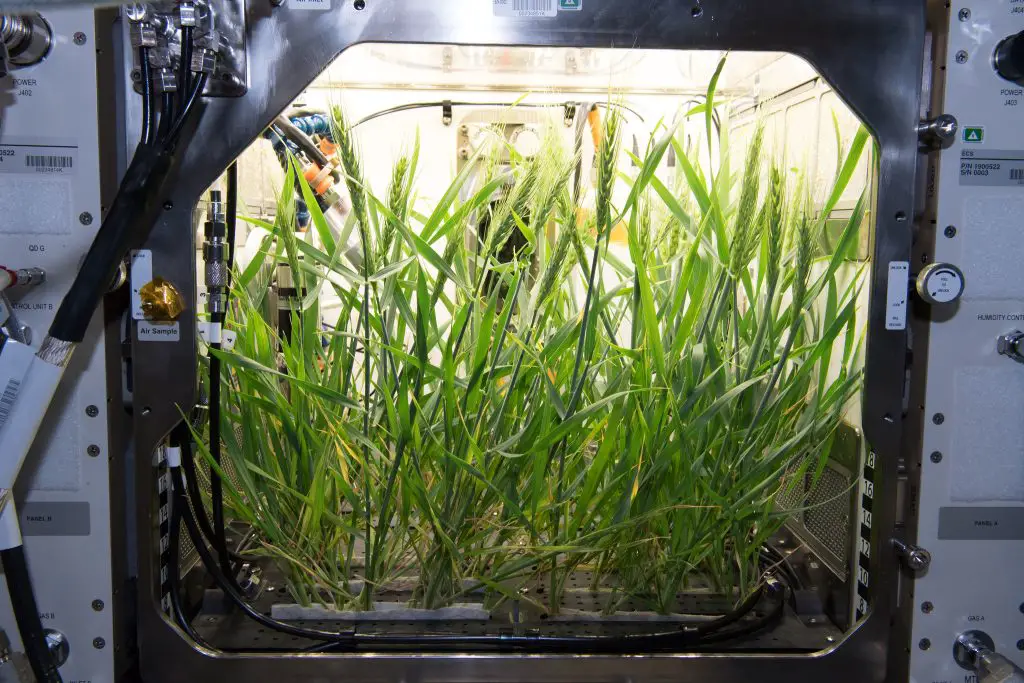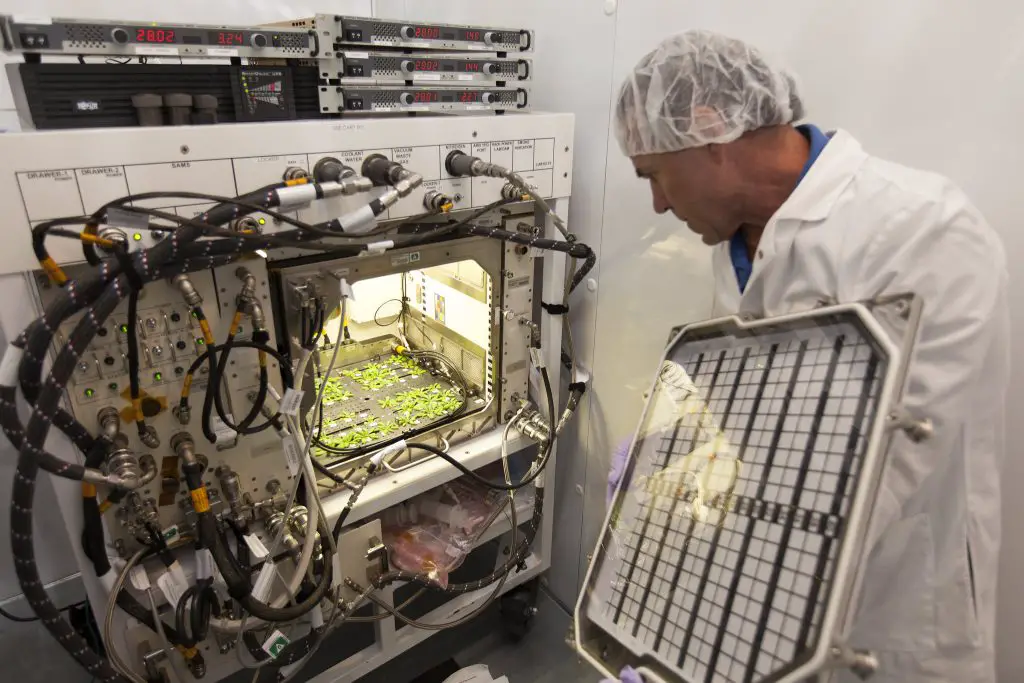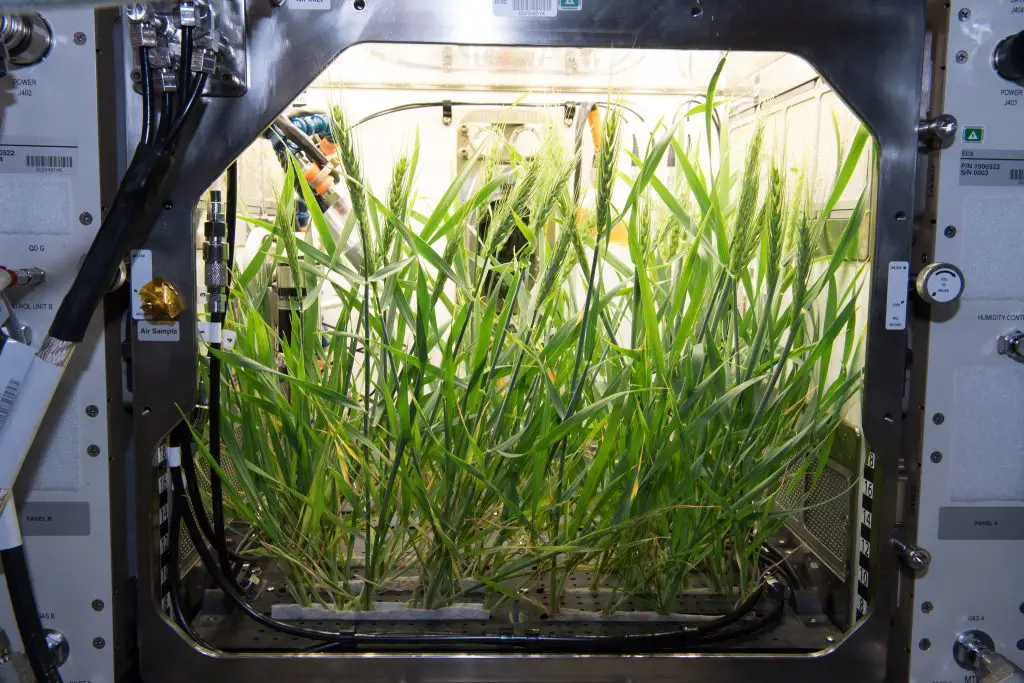Plants grow in zero gravity surroundings by maintaining their root systems in a nutrient-rich water solution. In this environment, the roots can grow in a more random pattern compared to the structured growth in plants on earth.
This allows the plants to absorb water and nutrients necessary for growth. Additionally, plants utilize special light sources to promote photosynthesis, which is crucial for their development. Scientists continue to study the effects of zero gravity on plant growth, ensuring that future space missions can sustain plant-based systems for food production and air regeneration.

Credit: global.jaxa.jp
The Effects Of Zero Gravity On Plant Growth
Plants have the incredible ability to adapt and thrive in the most challenging environments. But what happens when you take them out of their natural habitat and expose them to zero gravity? The effects of zero gravity on plant growth are both fascinating and complex.
In this blog post, we will explore the intriguing world of plant growth in outer space and uncover the changes in growth patterns, morphology, photosynthesis, and nutrient absorption challenges that plants face in zero gravity.
Plant Growth Experiments In Space
- Scientists have conducted numerous experiments to study plant growth in zero gravity.
- These experiments have been conducted both on the international space station and other space missions.
- The goal is to understand how plants respond to the unique environment of space and how we can leverage this knowledge for future space missions and sustainable agriculture.
Changes In Growth Patterns And Morphology
- In zero gravity, plants exhibit different growth patterns and morphology compared to their earth-bound counterparts.
- Due to the absence of gravitational forces, plants grow in a random, tangled manner, without an upward or downward orientation.
- Without the influence of gravity, plants have weaker and thinner cell walls, resulting in weaker stems and a less rigid structure.
Photosynthesis And Nutrient Absorption Challenges
- Photosynthesis, the process by which plants convert sunlight into energy, is significantly affected by zero gravity.
- In space, plants struggle to orient their leaves towards the light source, leading to reduced photosynthetic efficiency.
- The lack of gravity also affects the movement of water and nutrients within the plant, making it challenging for roots to absorb and distribute resources effectively.
These factors pose unique challenges for plant growth in space, but they also open up intriguing possibilities for future research and technology. By understanding how plants adapt and respond to zero gravity, scientists can develop innovative solutions for sustainable agriculture on earth and enable long-duration space missions.
So, the next time you gaze at the stars, remember that even in the vastness of space, plants continue to grow and thrive in their own extraordinary way.
Mechanisms Of Plant Adaptation To Zero Gravity
Plants are fascinating organisms with the ability to adapt to various environments. They have evolved to survive in diverse conditions, from scorching deserts to frozen tundra. But have you ever wondered how plants grow in zero gravity? In this blog post, we will explore the mechanisms of plant adaptation to zero gravity and unravel the incredible ways in which plants overcome the challenges of space travel.
Role Of Gravity In Plant Growth
Gravity plays a crucial role in the growth and development of plants on earth. It provides a constant force that helps the roots anchor themselves in the soil and allows the shoots to grow upward towards the sunlight. However, when exposed to zero gravity in space, plants encounter unique obstacles that require them to adapt in extraordinary ways.
Changing Patterns Of Gene Expression
In space, plants experience altered patterns of gene expression. The lack of gravity triggers a series of molecular responses within the plant’s cells, leading to changes in gene activity. This enables the plant to modify its growth and development strategies, optimizing its chances of survival in the weightless environment of space.
- Increased expression of stress-responsive genes: Plants activate specific genes that help them cope with the stress of zero gravity. These genes regulate various cellular processes, such as protein synthesis and repair mechanisms, to ensure the plant’s survival and growth.
- Regulation of growth-related genes: In the absence of gravity, plants exhibit changes in the expression of genes responsible for growth and development. This allows them to redirect their resources towards adaptive strategies, such as thicker stems and shorter roots, to maintain balance and stability.
Impact On Plant Hormones And Signaling Pathways
Plant hormones play a vital role in guiding the growth and development of plants. In zero gravity, the altered gravitational forces disrupt the normal distribution and signaling of hormones, leading to significant changes in plant behavior and adaptation.
- Ethylene production: Increased levels of ethylene, a gaseous plant hormone, have been observed in plants exposed to zero gravity. This hormone regulates various physiological processes, including fruit ripening and plant responses to stress. In space, elevated ethylene levels can influence the growth and morphology of plants, potentially affecting their overall health.
- Auxin redistribution: Auxin, another essential plant hormone, is involved in regulating plant growth and development. In zero gravity, the redistribution of auxin within the plant becomes altered, leading to modified growth patterns. Roots may exhibit random growth directions, and shoots may display slower growth rates compared to plants on earth.
Alterations In Root Growth And Development
Roots play a critical role in nutrient uptake, anchoring the plant, and providing structural support. However, in zero gravity, the absence of gravity-driven geotropism causes significant changes in root growth and development.
- Random root growth: Without the guidance of gravity, roots tend to grow in unpredictable directions. This phenomenon is known as clinorotation, where the roots continuously rotate, searching for resources and adapting to the weightless environment.
- Decreased root length: Plants in space often exhibit shorter root lengths compared to their terrestrial counterparts. This adaptation allows them to conserve energy and allocate resources more efficiently, as the availability of nutrients differs in the weightless environment.
Plants exhibit remarkable mechanisms of adaptation to zero gravity. From altering gene expression and hormone levels to modifying root growth and development, plants are able to survive and grow in space. Understanding these mechanisms not only expands our knowledge of plant biology but also has implications for future space exploration and potential extraterrestrial agriculture.
Strategies For Cultivating Plants In Zero Gravity Environments
How Do Plants Grow In Zero Gravity
Can plants survive and thrive in zero gravity environments? It might seem like an impossible feat, but scientists have been exploring ways to cultivate plants in space for years. In this blog post, we will delve into the strategies used to grow plants in zero gravity environments, focusing on hydroponic systems, recirculating nutrient solutions, artificial light and temperature control, and minimizing water usage and waste management.
Let’s dive in!
Hydroponic Systems For Space Gardening:
- In the absence of soil, hydroponic systems are used to provide plants with the necessary nutrients and water.
- These systems involve growing plants in a nutrient-rich water solution, eliminating the need for traditional soil-based growing methods.
- Hydroponics allows for precise control of nutrient delivery, ensuring that plants receive the optimal balance of minerals essential for their growth.
Recirculating Nutrient Solutions:
- In zero gravity, it is crucial to recirculate the nutrient solution to prevent it from drifting away.
- By continuously recycling the solution, it can be used more efficiently and reduces the need for additional resources.
- This recycling process helps to minimize waste and keeps the plants adequately nourished throughout their growth cycle.
Providing Artificial Light And Temperature Control:
- Natural sunlight is not available in space, so artificial light sources are employed to provide plants with the necessary light for photosynthesis.
- Led lights are the preferred choice as they are energy-efficient and emit specific wavelengths of light suitable for plant growth.
- Maintaining optimal temperature is equally important, as plants require specific temperature ranges to thrive. Controlled environments with temperature regulation systems are used to ensure ideal conditions for plant growth.
Minimizing Water Usage And Waste Management:
- Water is a precious resource in space, so minimizing its usage is essential.
- Techniques such as water recycling and capturing condensation are employed to reduce water consumption and ensure sustainability.
- Waste management systems are also in place to handle plant waste and prevent any unwanted build-up that may harm plant growth.
As we continue to explore space and aim for extended stays on other planets, the ability to grow plants in zero gravity environments becomes crucial. The strategies mentioned above provide valuable insight into how we can ensure the successful cultivation of plants in these extraordinary conditions.
By harnessing the power of hydroponics, nutrient recirculation, artificial lighting, and efficient water management, we can create self-sustaining environments and pave the way for future space missions.
Effect Of Microgravity On Root Orientation And Nutrition
How do plants grow in zero gravity? The effect of microgravity on root orientation and nutrition is a fascinating topic that lies at the heart of this question. In the absence of gravity, plants encounter unique challenges in their growth.
Let’s delve into the influences on root gravitropism, changes in nutrient uptake and distribution, and the role of plant-microbe interactions in nutrient acquisition.
Influences On Root Gravitropism:
- Root gravitropism refers to the growth of plant roots in response to gravity. In a normal terrestrial environment, roots grow downwards, towards the force of gravity.
- In zero gravity, roots do not experience a gravitational force to guide their growth. As a result, they exhibit random, wavering patterns as they search for a source of nutrients.
Changes In Nutrient Uptake And Distribution:
- Nutrient uptake and distribution are vital processes for plants to thrive. In microgravity conditions, these processes become altered due to the absence of gravity’s influence.
- Without gravity, nutrients are not distributed evenly throughout the plant. This can lead to irregular growth patterns and hinder overall plant development.
- Nutrients that are normally transported through xylem and phloem tissues may not flow as efficiently in zero gravity, impacting nutrient absorption and transport.
Role Of Plant-Microbe Interactions In Nutrient Acquisition:
- Plants rely on interactions with beneficial microbes to enhance nutrient acquisition, especially in challenging environments.
- In zero gravity, these interactions become crucial as plants struggle to obtain essential minerals and elements from the surrounding environment.
- Certain microbes can form symbiotic relationships with plant roots, aiding in the absorption of nutrients and facilitating their conversion into a usable form.
Understanding the effect of microgravity on root orientation and nutrition is crucial for cultivating plants successfully in space. By studying these influences, scientists and astronauts can develop strategies to ensure sustainable plant growth and support long-duration space missions. So, next time you ponder the marvels of plants growing in zero gravity, remember the fascinating interplay between root gravitropism, nutrient uptake and distribution, and plant-microbe interactions that contribute to their survival.
Impact Of Microgravity On Plant Reproduction And Development
It’s fascinating to imagine how plants would fare in zero gravity. Without the guidance of gravity, would they still be able to reproduce and develop as they do on earth? Let’s delve into the impact that microgravity has on plant reproduction and development in space.
Pollination Challenges In Space:
- In the absence of gravity, traditional methods of pollination, such as wind or insects, become ineffective.
- Plants in space rely heavily on artificial pollination, which is often carried out manually by astronauts.
- This process requires careful planning and execution to ensure successful pollination.
Formation Of Seeds And Fruit In Zero Gravity:
- Zero gravity affects the way seeds and fruits develop in plants.
- The lack of gravitational force can lead to irregular growth patterns, resulting in misshapen or underdeveloped seeds and fruits.
- The challenge of growing nutritious crops in space is further compounded by these unpredictable outcomes.
Effects Of Microgravity On Flower Morphology And Fertility:
- The morphology of flowers can be significantly altered in microgravity environments.
- Flowers might appear different, with changes in size, color, and overall structure.
- Microgravity can also affect the fertility of flowers, impacting the formation of viable pollen and successful fertilization.
Considering the challenges plants face in zero gravity, scientists and astronauts continue to explore innovative techniques to ensure the success of plant reproduction and development in space. By understanding the impact of microgravity on these processes, we can hope to develop sustainable methods to grow crops and provide for future long-duration space missions.
The Role Of Light And Environmental Factors In Space Gardening
Plants have been a crucial part of life on earth, providing us with oxygen, food, and beauty. But have you ever wondered how plants could survive and thrive in the challenging conditions of outer space? In zero gravity, plants face unique obstacles in their growth and development.
However, scientists and astronauts have found innovative ways to overcome these challenges and create sustainable gardens in space. In this blog post, we will delve into the role of light and environmental factors in space gardening, focusing on maintaining adequate light levels, controlling temperature and humidity, and managing gases and atmospheric composition for optimal growth.
Maintaining Adequate Light Levels For Photosynthesis
- Light is one of the key factors necessary for photosynthesis, the process through which plants convert sunlight into energy.
- In space, where natural sunlight is limited or even absent, artificial lighting systems become crucial for plant growth.
- Advanced led technologies are used to provide the right spectrum of light for photosynthesis, ensuring plants receive the energy they need to thrive.
- These systems can be programmed to mimic the natural sunlight conditions, including variations in intensity and duration, allowing plants to receive a balanced light exposure.
Controlling Temperature And Humidity In A Confined Space
- Temperature and humidity control is vital to create a suitable environment for plant growth in space.
- The confined spaces and lack of air circulation in spacecraft make it challenging to regulate temperature and humidity levels.
- Sophisticated climate control systems maintain the optimal temperature and humidity range, preventing excessive moisture accumulation or dehydration.
- By carefully managing these factors, scientists ensure that plants can grow in an environment that closely resembles earth’s conditions.
Managing Gases And Atmospheric Composition For Optimal Growth
- Just like on earth, plants in space require the right balance of gases and atmospheric composition for their growth.
- Carbon dioxide, a critical component for photosynthesis, is regulated inside the spacecraft to maintain ideal levels for plant respiration.
- Oxygen levels are monitored and adjusted accordingly to ensure the health of both plants and astronauts.
- Efficient air filtration systems prevent the accumulation of harmful gases and pollutants, guaranteeing a clean and healthy environment for plant growth.
The role of light and environmental factors in space gardening is undoubtedly complex. Scientists continuously strive to create innovative solutions to overcome the challenges posed by zero gravity. By maintaining adequate light levels, controlling temperature and humidity in confined spaces, and managing gases and atmospheric composition, astronauts and researchers pave the way for sustainable plant growth in outer space.
Advancements In Space Gardening For Long-Duration Space Missions
Plants have always been an integral part of life on earth, providing us with sustenance, oxygen, and a touch of nature’s beauty. But have you ever wondered how plants thrive in the seemingly inhospitable conditions of outer space? In this blog post, we will explore the advancements in space gardening for long-duration space missions and delve into the potential benefits it holds for sustainable food production, enhancing crew well-being and nutrition, and the feasibility of using bio-regenerative life support systems.
Sustainable Food Production In Space
- In the quest for sustained space exploration, the ability to grow food on spacecraft or space stations becomes crucial.
- Space gardening offers a viable solution to the challenge of providing astronauts with fresh and nutritious food during long-duration missions.
- By cultivating plants in zero gravity environments, scientists can experiment with different plant varieties and growing techniques to optimize food production.
- This sustainable approach offers the potential to reduce reliance on pre-packaged meals, ensuring astronauts have access to a diverse range of homegrown produce.
Enhancing Crew Well-Being And Nutrition
- It is well known that access to fresh food has a positive impact on our physical and mental well-being, and the same holds true for astronauts in space.
- Space gardening not only provides astronauts with nutritious fare but also offers a psychological boost by connecting them to familiar green environments.
- The act of tending and nurturing plants can be therapeutic, helping astronauts combat feelings of isolation and enhancing their overall well-being during prolonged space missions.
- Moreover, plants can play a crucial role in air purification, removing harmful substances and replenishing the spacecraft’s atmosphere with oxygen.
Potential For Bio-Regenerative Life Support Systems
- Bio-regenerative life support systems aim to create a self-sustaining ecosystem wherein astronauts can produce their own food, recycle waste, and generate resources.
- Space gardening plays a significant role in this vision by providing a renewable source of food, oxygen, and psychological support.
- Plant-based cultivation systems can help close the loop in resource management by utilizing carbon dioxide released by humans and waste organic matter as fertilizers.
- The integration of bio-regenerative systems paves the way for long-duration space exploration, reducing the dependence on resupply missions and making space travel more self-reliant.
Advancements in space gardening have the potential to revolutionize long-duration space missions by enabling sustainable food production, enhancing crew well-being and nutrition, and fostering the development of bio-regenerative life support systems. With further research and experimentation, we can unlock the full potential of plants as our companions in the vast expanse of space.
So, let us embark on this botanical voyage together and explore the wonders of space gardening one leaf at a time.
Plant Research And Biotechnology In Zero Gravity
Have you ever wondered how plants can grow in zero gravity conditions? The answer lies in the fascinating field of plant research and biotechnology in space. By understanding how plants respond to stressors and harnessing their unique properties, scientists have made remarkable discoveries in developing new varieties and bioactive compounds.
In this blog post, we will explore the opportunities that studying plants in zero gravity offers, from understanding plant responses to stressors to the development of new plant varieties and bioactive compounds. Let’s dive into the exciting world of plant research in space.
Opportunities For Studying Plant Responses To Stressors:
- Studying plants in zero gravity provides a unique environment to observe their responses to stressors such as radiation, microgravity, and limited resources.
- By examining how plants adapt and survive in these extreme conditions, scientists can gain valuable insights into how plants cope with stress on earth.
- Zero gravity also allows researchers to study the effects of stressors on plants without the influence of gravity, providing a clearer understanding of the underlying mechanisms.
Harnessing Unique Properties Of Plants Grown In Space:
- Plants grown in space exhibit unique characteristics due to the absence of gravity, such as altered growth patterns and increased production of secondary metabolites.
- Understanding these properties can lead to the development of new agricultural practices and technologies on earth, allowing for more efficient and sustainable crop production.
- The discovery of enhanced bioactive compounds in plants grown in space opens up new possibilities for the development of novel pharmaceuticals and nutraceuticals.
Developing New Varieties And Bioactive Compounds:
- By studying plants in zero gravity, scientists can identify genetic variations and traits that are beneficial for growth in extreme environments.
- This knowledge can be harnessed to breed new plant varieties with improved adaptation, resilience, and nutritional value.
- Additionally, the production of unique bioactive compounds in space-grown plants can be optimized and scaled up for various applications, from medicine to food supplements.
Plant research and biotechnology in zero gravity offer exciting opportunities to explore plant responses to stressors, harness unique plant properties, and develop new varieties and bioactive compounds. Through these endeavors, scientists aim to not only deepen our understanding of plant biology but also enhance crop production and the development of innovative products.
The wonders of zero gravity enable us to unlock the full potential of plants and pave the way for a greener and healthier future. So, let’s continue to explore the mysteries and benefits of plant research in space.
Frequently Asked Questions For How Do Plants Grow In Zero Gravity
How Do Plants Adapt To Zero Gravity?
Plants adapt to zero gravity by growing towards light, with their roots in the direction of moisture. They may also develop thicker stems to provide support in the absence of gravity.
How Do Plants Reproduce In Space?
Plants can reproduce in space through a process called vegetative propagation, where they produce new plants from their roots, stems, or leaves. They can also reproduce via pollination and seed production if the necessary conditions are provided.
Do Plants Need Soil To Grow In Space?
Plants do not necessarily need soil to grow in space. They can be cultivated using hydroponic systems, where they are grown in nutrient-rich water instead of soil. This allows plants to thrive in zero gravity environments.
How Is Water Supplied To Plants In Space?
In space, water is supplied to plants through a carefully controlled system. Using hydroponics, water is provided in a controlled manner, with the right amount of nutrients dissolved in it. The system ensures that plants receive adequate water for growth and development.
Are There Any Challenges To Growing Plants In Zero Gravity?
Growing plants in zero gravity comes with its challenges. The absence of natural gravity can affect the way plants grow and orient themselves. Issues like water management, root anchorage, and air quality control need to be overcome to ensure successful plant growth in space.
How Are Plants Affected By Zero Gravity?
Plants in zero gravity have been found to experience changes in their growth patterns. They may grow at a slower rate, develop weaker cell walls, and exhibit changes in root architecture. These adaptations are necessary for plants to survive and thrive in an environment with no gravity.
Conclusion
In the challenging environment of space travel, scientists have made impressive strides in understanding how plants grow in zero gravity. The experiments conducted on the international space station have shed light on the complex processes involved in plant growth and development, highlighting their resilience and adaptability.
Despite the absence of gravity, plants are able to orient themselves and adjust their growth patterns towards light sources. This is made possible by specialized cellular mechanisms that respond to environmental cues. Moreover, the presence of root cap cells helps guide the direction of root growth, ensuring plants are able to anchor themselves and absorb necessary nutrients.
These findings have significant implications for future space missions, as they demonstrate the potential for growing fresh food in the harsh conditions of space, supporting long-duration missions and even habitation on other planets. As we continue to advance our understanding of plant biology in zero gravity, we come one step closer to realizing the dream of sustainable agriculture beyond earth’s boundaries.




